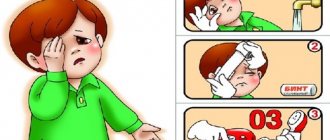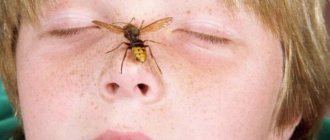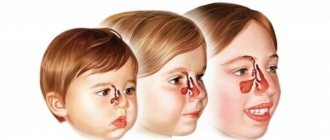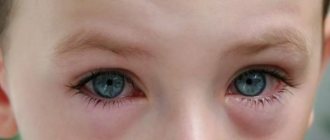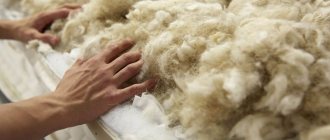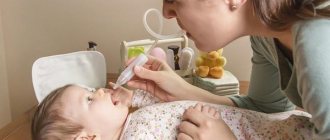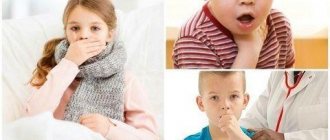The concept of conjunctivitis: what are the features of this disease
The mucous membrane of the eye, which is a thin transparent film covering the eyeball and the inside of the eyelids, is called the conjunctiva.
In this article
- The concept of conjunctivitis: what are the features of this disease
- Features of conjunctivitis in children aged 4 years
- How is conjunctivitis treated for children aged 4 years?
- How to determine the type of conjunctivitis in a child?
- Viral conjunctivitis - how to treat it?
- How should allergic and bacterial conjunctivitis be treated?
A healthy conjunctiva protects the visual organs from external factors, produces important components of lacrimal secretion, wetting and moisturizing the eyeball. Therefore, the comfort of the child’s eyes directly depends on the health and proper functioning of the conjunctiva. If the mucous membrane becomes inflamed for some reason, then severe discomfort, burning, itching and other unpleasant sensations often occur. An inflammatory reaction can occur to different types of irritants, including allergens, infectious diseases, and exposure to chemicals. Any process of inflammation of the mucous membrane of the eye is called conjunctivitis.
Features of conjunctivitis in children aged 4 years
Children's conjunctivitis, according to ophthalmologists, is much more common than in adults. At 4 years old, most children are already familiar with this disease and may have encountered it more than once. In many preschoolers, eye inflammation regularly occurs as one of the symptoms of a viral infection; For others, it results from bacteria getting into the eyes. Children prone to allergies can react to allergic irritants in this way. You can suspect the development of conjunctivitis in a child aged 4 years by the visible signs and symptoms that the child complains of.
Children's conjunctivitis can manifest itself as follows.
- The baby constantly scratches and rubs his eyes.
- You notice redness of the mucous membrane, which can vary in intensity - from very weak to pronounced.
- In the morning (sometimes throughout the day), a discharge appears in the eyes, which can be purulent or transparent. After sleep, it may be difficult to open your eyes due to stuck eyelashes.
- The eyelids are usually swollen.
- A child may squint at the light, cover his eyes, because bright lighting causes him unpleasant and painful sensations.
- In some cases, children may complain that their eyes hurt.
If you notice one or more symptoms from this list in your child, it is recommended to show him to the doctor as soon as possible. Despite the fact that in most cases, childhood conjunctivitis goes away without a trace within a few days or weeks, there are dangerous forms that can lead to irreparable consequences for vision.
a child's eye is inflamed, how to treat it
I haven’t written anything for a thousand years, but I need to write about it, otherwise with my memory...
In general, on January 18, we visited a homeopath for the first time. Her name is Marina Alekseevna from Kuznechikov (outside Podolsk). We came to her to treat our adenoids and all the ailments like them.
She said that adenoids are bullshit, but we will treat atopy for a long time. At the reception, she gave me one pea and said that in a week I would give him more. She explained how it all works, resonance occurs in the body... but it went into one ear and out of the other. But as my Zhenya (sister) explained to me, the essence is this. Now these peas, with the help of symptoms (which I write down daily or as they appear) should show the true sore that sits in Lyonka. And so briefly about them:
1. During these two months, Lyonka was sick twice, both times with a temperature (37-37.9), which is very rare for us (but fever is good, the immune system began to struggle). In the first days (two, three weeks) Leni came out with green snot, it didn’t flow, but in the morning he blew his nose well. The cough was strong, to the point of vomiting. AND THE MOST IMPORTANT THING IS NOT TO TREAT A CHILD WITH MEDICATIONS, drink plenty of fluids, rinse the nose, inhale with saline. 2. Lenka vomited so many times during these two months both because of a cough and because his dad swore at him (because of the latter, we were very worried that it was psychological for him) But no))) Marina Alekseevna said that in theory it was supposed to relax stool (in most cases this is exactly what happens) but our sore took a different path.
3. The scabs on the head that sat so tightly that it was impossible to tear them off, after two weeks or a month they began to come off on their own with severe itching and even hair (two or three scabs and this lasted only a couple of hours).
4. periodically Lenya slept poorly (little)
5. Damn, I barely remember how it started, but definitely already in mid-March, Lenya felt bad (I think this was when he got sick for the second time), he had a fever, he woke up in the afternoon and asked for food (yes, yes, he was sick and ate bad these days) while I went to prepare porridge, he asked for my apple, ate probably a quarter of the apple and began to complain very much about his stomach, I thought it was because he was hungry and because the apple didn’t go well on an empty stomach, so I shoved the porridge at him, He ate the spoon and vomited several times (until this apple came out). Then he felt better that even in the evening he was already jumping and running. but once he complained about his butt. In the morning he complains again, I looked at him, and there was all the delicate skin (folds) of his butt, everything was inflamed and purple in color, the crust was just so hard - of course I was shocked, but we smeared it with bepanthen a couple of days and his skin / crust came off quickly and again everything is fine))).
On March 23, we went to the grasshoppers for the second time, after listening to me and taking my notes, she gave me one pea (something with white-bottomed and something else), in general, she said that with such a pea, you can give some kind of medicine, in general, if anything happens, call her and she will say. DO NOT MAKE MANTOUS UNDER ANY CASE!!! because the consequences will not be good. Now I’m tormented about how not to make mantu and not to quarrel with the garden. Marina Alekseevna also prescribed him a month of glycine forte and another 3 months to drink L... (I forgot what it’s called))) from March 27 we’ve been giving glycine forte one at a time (and myself I drink)))
So I’ll write about the symptoms further:
1. 3.04 after the garden he began to complain of a headache, it hurt badly. Even when we first arrived home, I noticed that his eyes were tired (in a bunch) and he didn’t eat. I decided to put him to sleep - he fell asleep a minute later at half past seven and woke up at half past seven in the morning (slept in his bed) in general, my opinion is that he was overtired, since before that he fell asleep very late two evenings (the previous night he fell asleep at half past one) and sometimes he doesn’t sleep in the garden.
How is conjunctivitis treated for children aged 4 years?
As qualified doctors say, childhood conjunctivitis is only half the diagnosis. This term refers to any inflammation of the mucous membrane of the eye in a baby. But in order to prescribe adequate and effective treatment to your child, you need to understand why the inflammatory process began. Children's conjunctivitis is usually divided into several types, taking into account the cause of its occurrence. Each form of the disease requires different methods and duration of treatment.
- Viral childhood conjunctivitis.
One of the most common is the viral form of conjunctivitis. In this case, inflammation is provoked by various types of viruses. By multiplying on the mucous membrane of the eye, they lead to the appearance of characteristic symptoms of conjunctivitis.
- Bacterial childhood conjunctivitis.
Inflammation can be caused by bacteria entering the mucous membrane. It is this form of conjunctivitis that is characterized by purulent discharge from the eyes.
- Allergic conjunctivitis in children.
Sometimes children's conjunctivitis occurs as a reaction to a specific allergen (pollen, animal dander and other irritants).
It turns out that conjunctivitis in a child can have a different nature and mechanism of occurrence. And the treatment that will be effective against the bacterial form of the disease will not help with the allergic form, and vice versa. Thus, the main task of parents and the doctor is to establish the exact cause of the disease, after which it will be possible to prescribe effective drugs.
Features of drug treatment
An accurate diagnosis should be entrusted to an ophthalmologist, then the treatment will be effective and the recovery period in children will be as fast as possible.
The most effective way when the baby’s vision organs are inflamed is eye drops. They are prescribed depending on what factors influenced the onset of the disease.
If there is a bacterial infection or a cold, then it is necessary to treat it with drops of drugs with an antibiotic substance. If there are problems with the tear ducts in a newborn, drops will be prescribed whose composition resembles human tears.
In general, treatment in different cases is carried out as follows:
- Conjunctivitis has occurred, which means drops with an antibacterial effect (Levomycetin, Sodium Sulfacyl) will be useful.
- Drops such as Penicillin and erythromycin solution will help to cope with blepharitis, abscess, and boil.
- Drops “Licontin”, “Oxial”, “Ophtolik” will help to improve the functioning of the lacrimal organs.
- Inflammation of an allergic nature will be removed by Visin drops.
That is, there are certain rules that are extremely important to follow:
- if a newborn is being treated, before the procedure he is swaddled and placed on a flat surface. It is necessary to treat not only the diseased eye, but also the one that is not affected by the infection;
- Only clean bandages, napkins or cotton wool should be used. Be sure to wash your hands thoroughly before using the product;
- any drops or ointments are used as described in the instructions. And everything should be done at the appointed time. Procedures cannot be skipped, otherwise the treatment will be useless.
How to determine the type of conjunctivitis in a child?
Despite the fact that there are some distinctive features between different types of conjunctivitis (for example, with a viral discharge, the discharge has a transparent structure, and with a bacterial one, it is purulent; with a viral one, one eye is often affected, and with an allergic one, both are affected), the symptoms often overlap and it is difficult to identify the cause diseases. In this case, parents can help in making a diagnosis. Doctors recommend remembering what events or actions of the child preceded the onset of the inflammatory process. If, for example, just recently several children in kindergarten suffered from conjunctivitis, then there is a high probability that the child has a viral type of the disease. If inflammation appears after the baby has visited a place where there is a cat, then we can assume the allergic nature of the pathology. Based on a detailed history, ophthalmological examination and, if necessary, additional tests, the doctor will be able to establish an accurate diagnosis.
Viral conjunctivitis - how to treat it?
drops, but it should be understood that they do not destroy viruses, but are aimed at activating the body’s defenses. If a child has viral conjunctivitis, the only way you can safely treat it before consulting a doctor is to wash the eyes. You can rinse the mucous membrane with saline solution, purchased at a pharmacy or prepared yourself (one teaspoon of salt per liter of water). Washing helps remove viruses from the mucous membranes and increases the baby’s comfort. Also, in case of a viral form of the disease, it is useful to rinse the nose as well. The eyes and nasal cavity are anatomically connected by the nasolacrimal canal, so all microbes that enter the conjunctiva easily end up on the nasal mucosa and vice versa. Rinsing will help speed up recovery and prevent the infection from spreading into the nasopharynx.
Such forms of viral conjunctivitis as herpetic and adenoviral deserve special attention. The first, caused by the herpes virus, is considered the most dangerous in terms of eye damage and without adequate treatment can lead to irreversible consequences for vision. Herpetic conjunctivitis in children can be identified by such a characteristic symptom as the presence of blisters on the upper eyelid, and this is a serious reason to immediately consult a doctor. As a rule, in the treatment of this form of inflammation, acyclovir drugs and other drugs are used that are aimed at combating the herpes virus. The adenoviral type of conjunctivitis is also dangerous for its complications. If left untreated, adenoviruses can penetrate the deep tissues of the eye, infect the cornea and negatively affect vision.
Adenoviral conjunctivitis in a 4-year-old child can be recognized by a triad of symptoms - fever, inflammation of the mucous membranes of the eyes and redness of the throat. This is one of the most contagious forms of viral conjunctivitis, in which it is important to avoid contact with other people. Therapy may include antiviral drugs, antibiotics if there is a risk of bacterial infection, and moisturizing drops.
Recipes for treatment with folk remedies:
Chamomile. Steamed in boiling water and infused for 40-50 minutes, it is used as an eye wash.
Tea infuser. Ordinary cotton pads are moistened with fresh tea leaves and applied to closed eyes. Additionally, to enhance the effect, you can wash your face.
Chicken eggs. Separate the white from the yolk, add a little water to the first, and use it in the same way as an eye wash. The product is prepared for one-time use.
Yarrow. Used as a compress.
Dill and aloe juices. Dilute with warm water and use as in the previous recipe.
Tea rose. The petals are boiled in boiling water, then infused and the resulting “potion” is used to wash the eyes.
Bay leaf. Used as an infusion for washing and night eye lotions.
Cereals. Mix with sour milk and use as a compress.
Cow's milk. For washing and applying to the eyes for inflammation.
Dew. In the old days it was considered one of the best remedies in the fight for eye health.
Eye baths. Dip your head into warm boiled water and blink.
Bird cherry. Use the infusion as compresses.
Sour cream. It is supposed to be used after opening the abscess, on an open wound.
In addition to conjunctivitis, there are other inflammatory diseases, both of the eye itself and parts of the eye organ - barley, blepharitis, phlegmon, boil, keratitis.
How should allergic and bacterial conjunctivitis be treated?
Allergic conjunctivitis is treated with pediatric antihistamines. The doctor may prescribe both hormonal and non-hormonal antiallergic drugs. The former act faster, the latter are considered safer, but the effect of the treatment is not immediately noticeable. However, in the treatment of an allergic form of the disease, it is not enough to know how to treat conjunctivitis in a child. It is much more important to find and eliminate the cause of the allergic reaction. Otherwise, the baby will have to “live on drops”, because the allergen will again and again provoke the inflammatory process.
Sometimes a child brings bacteria into his eyes with dirty hands, or they get there in another way. In this case, bacterial conjunctivitis develops - how to treat it? In pediatric ophthalmology, local antibiotics in the form of drops or ointments are widely used. For a four-year-old child, the following treatment regimen is often prescribed: during the day, drops should be used every four hours or more often, and antibacterial ointments should be placed in the conjunctival cavity at night. This is explained by the fact that drop preparations have a shorter-term effect, while ointments, due to their structure, linger longer on the surface of the conjunctiva, providing a long-lasting therapeutic effect.
If you have a question about how to treat conjunctivitis in children, we recommend that you first make an appointment with an ophthalmologist. Children's conjunctivitis is very diverse in forms and pathogens, as a result of which treatment regimens must be selected individually for each child. It is advisable to consult a doctor if any symptoms of eye inflammation appear, but there are signs that require increased attention and immediate medical attention. These include no improvement within two days, blisters on the upper eyelid, photophobia, and eye pain. If a child has at least one of these symptoms, you should contact an ophthalmologist immediately.
Remember that competent, timely ophthalmodiagnosis and a professional approach to treatment are a guarantee of your baby’s eye health.
Medicines for the treatment of eye inflammation in children
When a child has an eye infection, treatment usually involves the use of medications prescribed by a doctor. Let's make a brief overview of drugs widely used in pediatrics to treat the eyes of young patients.
| A drug | Group | Active substance | Indications | Mode of application |
| Fucithalmic (drops); 0+ | Antibiotics. | Fusidic acid. | Conjunctivitis, dacryocystitis and other bacterial eye lesions. | 1 drop twice a day for 7 days. |
| Albucid (drops); 0+ | Sulfacyl ntaria. | To prevent blenorrhea: 2 drops after birth and the same amount after 2 hours. For the treatment of bacterial eye diseases - 1-2 drops every 4-6 hours until symptoms disappear. | ||
| Tsiprolet;(drops); 1+ | Ciprofloxacin. | The first two days - 1 drop every 2 hours. Then for five days - every 4 hours, 1 drop. | ||
| Ophthalmoferon; 0+ | Antiviral, immunomodulatory, antihistamine. | Human interferon. | Allergic and viral inflammatory eye diseases. | In acute cases - 1-2 drops every 3-4 hours. As the symptoms weaken, the number of instillations is reduced to 2-3 times a day. Treatment is continued until signs of inflammation completely disappear. |
| Aktipol; 0+ | Antiviral. | Para-aminobenzoic acid. | Viral eye infections. | 1-2 drops 2-8 times a day until symptoms disappear. Continue for another 7 days, instilling 2 drops twice a day. |
| Allegordil; 4+ | Antiallergic. | Phthalazinone derivatives | Allergic conjunctivitis. | 1 drop 2 to 4 times a day. |
Attention! To give the drops to your child, wash your hands with soap. Then place your baby on a pillow and gently pull down the lower eyelid. Apply a few drops (as prescribed by your doctor). Make sure your child does not toss and turn for several minutes. Then the medicine will have time to be absorbed and will not leak out.



